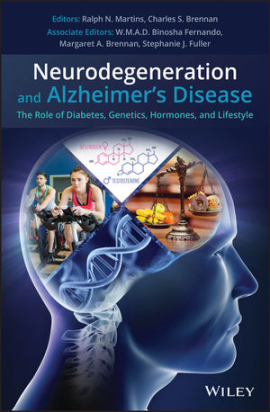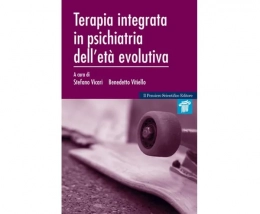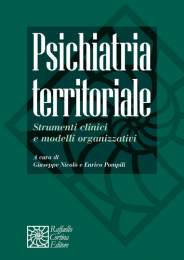Non ci sono recensioni
DA SCONTARE
Understanding the impact of diet, exercise, genetics, and hormones on the risk and development of Alzheimer’s and other neurogenerative diseases
Diet is widely known to impact on neurological function. Nevertheless, academic texts discussing this relationship are relatively few in number. This book therefore fills an important gap in the current literature. Opening with an overview of neurodegenerative diseases, particularly Alzheimer’s disease, the text then focuses on explaining the means by which glycemic control and lipid metabolism – and associated nutritional and lifestyle variables – may factor into such disorders’ prevention and treatment.
An international group of experts in the fields of food science and neurodegeneration have contributed chapters that examine Alzheimer’s disease within a broad range of contexts. Offering dietary, genetic, and hormonal perspectives, the authors explore topics ranging from sugar consumption to digestive fermentation, and Alzheimer’s disease animal models to the cognition-enhancing effects of physical exercise. Also included are overviews of the latest research into current and developing methods of treatment and diagnosis, as well as differential diagnostics. This groundbreaking book:
- Explores how glucose metabolism, insulin resistance, lipid metabolism, and high intake of refined carbohydrates are linked to Alzheimer's disease
- Discusses how genetic makeup can impact risk of Alzheimer’s and Parkinson’s disease
- Examines cognitive changes in neurodegeneration, lists current tests for determining cognitive impairment, and provides information concerning differential diagnosis
- Discusses potential advantages of increasing antioxidant and micronutrient intake
- Reviews hormonal influences on neurodegeneration
- Examines the links between protein intake and Alzheimer’s disease.
Neurodegeneration and Alzheimer's Disease is an essential resource for researchers, medical practitioners, dietitians, and students with an interest in neurological diseases and their diagnosis and risk factors, as well as diet-related conditions such as diabetes and obesity. Lifestyle and diet influence neurodegeneration risk, and a better understanding of this evidence amongst health professionals will hopefully lead to greater public awareness of how to reduce the likelihood of these widespread conditions.
List of Contributors xv
1 Current Understanding of Alzheimer’s Disease and Other Neurodegenerative Diseases, and the Potential Role of Diet and Lifestyle in Reducing the Risks of Alzheimer’s Disease and Cognitive Decline 1
Charles S. Brennan, Margaret A. Brennan, W.M.A.D. Binosha Fernando and Ralph N. Martins
References 7
2 Alzheimer’s Disease and Other Neurodegenerative Diseases 9
Stephanie J. Fuller, Hamid R. Sohrabi, Kathryn G. Goozee, Anoop Sankaranarayanan and Ralph N. Martins
2.1 Introduction 9
2.2 Alzheimer’s Disease 9
2.2.1 Pathology 9
2.2.2 Symptoms 10
2.2.3 Incidence 11
2.2.4 Onset and Risk Factors 12
2.2.5 Treatment 12
2.2.6 Potential for AD Prevention 13
2.3 Frontotemporal Lobe Dementia 13
2.3.1 Neuropathology and Causes 14
2.3.2 Treatment 15
2.3.3 Diagnosis and Clinical Overlap with Other Diseases 15
2.4 Vascular Dementia 16
2.4.1 Symptoms and Diagnosis 16
2.4.2 Causes and Risk Factors 16
2.4.3 Prevention and Treatment 17
2.4.4 Dementia with Lewy Bodies 18
2.4.5 Causes 18
2.4.6 Symptoms 18
2.4.7 Diagnosis of DLB 18
2.4.7.1 Clinical Approach to Dementias 19
2.5 Parkinson’s Disease 19
2.5.1 Onset 22
2.5.2 Causes and Risk Factors 22
2.5.3 Incidence 22
2.5.4 Pathology 22
2.5.5 Treatment 23
2.6 Huntington’s Disease 24
2.6.1 Genetics of the Disease 24
2.6.2 Incidence and Prevalence 25
2.6.3 Pathology 25
2.6.4 Treatment 26
2.7 Motor Neuron Diseases 27
2.7.1 Amyotrophic Lateral Sclerosis 27
2.7.2 Spinal Muscular Atrophy 27
2.7.3 Hereditary Spastic Paraplegia 27
2.7.4 Onset of MND and Differential Diagnosis 28
2.7.5 Incidence, Causes, and Risk Factors 28
2.7.6 Pathology 29
2.7.7 Treatment 30
2.8 Prion Diseases 30
2.8.1 Causes 31
2.8.2 Symptoms and Diagnosis 31
2.8.3 Treatment 32
2.8.4 Differential Diagnosis of the Various Types of Dementia 32
2.8.5 DLB Treatment 33
2.9 Summary 33
References 34
3 Current and Developing Methods for Diagnosing Alzheimer’s Disease 43
Stephanie J. Fuller, Nicholas Carrigan, Hamid R. Sohrabi and Ralph N. Martins
3.1 Introduction 43
3.2 Classical Post-Mortem Diagnosis 43
3.2.1 Plaques 44
3.2.2 Neurofibrillary Tangles (NFT) 44
3.2.3 Cerebral Amyloid Angiopathy (CAA) 44
3.2.4 Glial Responses 45
3.2.5 Brain Shrinkage 45
3.2.6 Loss of Synapses and Neurons 45
3.3 Clinical Diagnosis 45
3.3.1 Initial Assessment/Screening Tools 47
3.3.1.1 Mini-Mental State Examination (MMSE) 47
3.3.1.2 Montreal Cognitive Assessment (MoCA) 47
3.3.1.3 Clinical Dementia Rating (CDR) 47
3.3.1.4 Clock Drawing 48
3.3.1.5 Seven-Minute Screen 48
3.3.1.6 Alzheimer’s Disease Assessment Scale (ADAS-Cog) 48
3.3.1.7 Psychogeriatric Assessment Scales (PAS) 48
3.3.1.8 Dementia Rating Scale (DRS) 49
3.3.1.9 Mini-Cog 49
3.3.1.10 Rowland Universal Dementia Assessment Scale (RUDAS) 49
3.3.1.11 The Consortium to Establish a Registry for Alzheimer’s Disease (CERAD) Neuropsychological Battery (nb) and Other Tests 49
3.4 Brain Imaging in the Diagnosis of Alzheimer’s Disease and Other Dementias 51
3.4.1 Imaging Tests in AD Diagnosis: Established Tests 51
3.4.1.1 Computed Tomography (CT) 51
3.4.1.2 Electroencephalography (EEG) 51
3.4.1.3 Magnetic Resonance Imaging (MRI), for the Assessment of Morphological Changes, and the Detection of Stroke 52
3.4.1.4 Positron Emission Tomography (PET) 52
3.4.1.5 FDG-PET 52
3.4.2 Imaging Tests in AD Diagnosis: More Recently Developed Tests 52
3.4.2.1 MRI for Measuring Regional Blood Flow 53
3.4.2.2 Single Photon Emission Computed Tomography (SPECT) Scan 54
3.4.2.3 PiB-PET 54
3.4.3 The Rapidly Evolving Diagnostic Criteria 55
3.4.4 CSF Biomarkers of AD 56
3.4.4.1 Aβ, Tau, and AβPP-Related Biomarkers 56
3.4.4.2 Other Potential CSF Protein Biomarkers 57
3.4.4.3 Potential Lipid Biomarkers in the CSF 58
3.4.5 Blood Biomarkers of AD 60
3.4.5.1 Aβ Peptides in Plasma 60
3.4.5.2 Other Potential Blood Biomarkers 62
3.4.5.3 Blood Proteins 62
3.4.6 Blood Lipids 64
3.4.7 Metabolites 65
3.4.8 Blood Platelets 66
3.4.9 Genetic Risk Factors 67
3.4.10 The Eye as a Window to the Brain 68
3.4.11 miRNA Tests 69
3.5 Conclusions 71
References 72
4 The Link Between Diabetes, Glucose Control, and Alzheimer’s Disease and Neurodegenerative Diseases 89
Giuseppe Verdile, Paul E. Fraser and Ralph N.Martins
4.1 Introduction 89
4.2 The Impact of Type 2 Diabetes on the Brain 90
4.3 Evidence from Cell Culture, Animal, and Clinical Studies 93
4.3.1 CNS Insulin Signalling and Disruptions in AD 93
4.3.2 The Accumulation of Aβ Is Associated with Impaired Insulin Signalling 94
4.3.3 Insulin Resistance Promotes the Accumulation of Aβ 95
4.3.4 Impairments in Insulin Signalling Can Induce Hyperphosphorylation of Tau 96
4.3.5 Type 2 Diabetes and Neuroinflammation 96
4.3.6 Oxidative Stress and Mitochondrial Dysfunction in T2D and AD 97
4.3.7 Targeting Type 2 Diabetes to Slow Down Progression/Prevent Neurodegeneration and Cognitive Decline 99
4.4 Conclusions 103
References 103
5 Diet and Nutrition, and their Influence on Alzheimer’s Disease and other Neurodegenerative Diseases 117
Stephanie R. Rainey-Smith, Rhona Creegan, Stephanie J. Fuller, Michele L. Callisaya and Velandai Srikanth
5.1 Introduction 117
5.2 Dietary Patterns 118
5.3 Key Macronutrients 119
5.3.1 Dietary Fatty Acids 119
5.3.2 Cholesterol 120
5.3.3 Polyunsaturated Fatty Acids 121
5.3.4 Dietary Carbohydrates 122
5.4 Key Micronutrients 124
5.4.1 Water Soluble Vitamins 125
5.4.1.1 B Vitamins 125
5.4.2 Fat Soluble Vitamins 128
5.4.2.1 Vitamin A (Retinol, Retinal, and Retinoic Acid) 128
5.4.2.2 Vitamin D 129
5.4.2.3 Vitamin E 130
5.4.3 Dietary Minerals 131
5.4.3.1 Selenium 131
5.4.3.2 Manganese 132
5.4.3.3 Zinc, Iron, Copper, and Calcium 132
5.5 Conclusion 134
References 135
6 Carbohydrate and Protein Metabolism: Influences on Cognition and Alzheimer’s Disease 149
W.M.A.D. Binosha Fernando, Veer B. Gupta, Vijay Jayasena, Charles S. Brennan and Ralph N.Martins
6.1 Carbohydrates 149
6.1.1 Carbohydrate Digestion 149
6.1.2 Glucose Ingestion and Use 151
6.1.3 Glucose and Insulin, Insulin Resistance, and Type 2 Diabetes (Short Summary) 151
6.1.4 Relative Intake of Carbohydrate and Its Impacts on Neurodegenerative Disease Risk 152
6.1.5 Ketogenic Diets 154
6.1.6 Glucose and Its Effects on Cognition 154
6.1.7 Possible Mechanisms Related to Memory Enhancement with Glucose 157
6.1.7.1 Glucose and the Hippocampus 158
6.1.7.2 Glucose Availability in Brain Cells 158
6.1.7.3 Glucose and the Central Cholinergic System 159
6.1.7.4 ATP-Regulated Potassium (K-ATP) Channels and Brain Control of Glucose Homeostasis 159
6.1.7.5 Effects of High Fructose Diets 160
6.1.7.6 Sucrose 161
6.2 Proteins 161
6.2.1 Protein Metabolism in General 162
6.2.2 Links Between Specific Amino Acids and Brain Function 163
6.2.2.1 Tryptophan 163
6.2.2.2 Tyrosine 164
6.2.3 Clinical Studies of Protein Supplementation 165
6.2.4 Links Between Loss of Protein Function and Neurodegeneration 167
6.2.5 Clearance Mechanisms Associated with Proteinopathies Involved in Neurodegeneration 168
6.2.6 Role of Protein Crosslinking and Inflammation in Neurodegeneration and AD 170
6.3 Conclusion 171
References 171
7 Fat and Lipid Metabolism and the Involvement of Apolipoprotein E in Alzheimer’s Disease 189
Eugene Hone, Florence Lim and Ian J. Martins
7.1 Introduction 189
7.2 Alzheimer’s Disease 189
7.3 Cholesterol and Lipid Metabolism 190
7.3.1 Cholesterol Synthesis and Metabolism 190
7.3.2 Oxysterols 191
7.3.2.1 Oxysterols in AD 191
7.3.3 Pathways of Dietary (Exogenous) Lipid Homeostasis 192
7.3.4 Pathways of Endogenous Lipid Homeostasis 193
7.3.5 Peripheral Clearance of Lipoproteins and Reverse Cholesterol Transport 195
7.3.5.1 Lipoproteins in the CNS 197
7.4 Apolipoprotein E Alleles and Isoforms 197
7.4.1 ApoE in the Brain 198
7.4.2 Apolipoprotein E and Alzheimer’s Disease 198
7.4.2.1 ApoE Binding to Aβ 199
7.4.2.2 ApoE in the Cellular Clearance of Aβ 200
7.4.2.3 ApoE and Antioxidant Properties 201
7.4.2.4 ApoE and Tissue Transglutaminase 201
7.4.2.5 Apolipoprotein J (Clusterin, CLU) 202
7.5 LRP-1 in the Brain and Its Role in Aβ Clearance 203
7.5.1 LDL, HDL, and AD 203
7.5.2 Statins, Cholesterol, and AD 204
7.6 The Role of Lipid Rafts in Neurodegenerative Diseases 205
7.7 Changes to Glycerophospholipids in Alzheimer’s Disease 206
7.7.1 Omega-3 and Omega-6 Fatty Acids 207
7.7.1.1 Omega-3 Fatty Acids, Modern Diets, and Health Implications 208
7.8 Sphingolipids 208
7.8.1 Ceramides 208
7.8.2 Sulfatides 209
7.8.3 Gangliosides 209
7.9 Conclusions 210
References 210
8 Inflammation in Alzheimer’s Disease, and Prevention with Antioxidants and Phenolic Compounds –What Are the Most Promising Candidates? 233
Matthew J. Sharman, Giuseppe Verdile, Shanmugam Kirubakaran and Gerald Münch
8.1 Introduction 233
8.2 Inflammation and the Immune Response in AD 233
8.2.1 The Role of Microglia and Astrocytes in Chronic Inflammation in AD 233
8.3 Oxidative Stress 236
8.3.1 Advanced Glycation End Products 237
8.3.2 Involvement of the Complement System in AD 238
8.3.3 Involvement of Cytokines and Chemokines in Inflammation 239
8.3.4 Inflammation – Susceptibility to Aβ Deposition or Aggregation 240
8.3.5 Inflammation Can Influence AβPP Metabolism and Aβ Clearance Directly 241
8.4 Current Medications for AD 242
8.4.1 Current Medications – Acetylcholinesterase Inhibitors and Memantine 242
8.5 Disease Modification and Treatment Approaches 243
8.5.1 Non-Steroidal Anti-Inflammatory Drugs (NSAID) 243
8.6 Some Anti-inflammatory Foods, Supplements, and Newly Developed Drugs for the Treatment of AD 244
8.6.1 Cinnamon/Cinnamaldehyde 244
8.6.2 (−)Epigallocatechin-3-Gallate (EGCG) and Other Green Tea Polyphenols 245
8.6.3 Curcumin 247
8.6.4 Other Polyphenolic Antioxidants 248
8.6.5 Omega-3 (n-3) Essential Fatty Acids 249
8.6.6 Lipoic Acid 250
8.7 Conclusion 253
References 253
9 Cognitive Impairments in Alzheimer’s Disease and Other Neurodegenerative Diseases 267
Hamid R. Sohrabi and Michael Weinborn
9.1 Introduction 267
9.2 Dementia due to Alzheimer’s Disease 268
9.2.1 Subjective Cognitive Decline [4] and Mild Cognitive Impairment (MCI) 268
9.2.2 Memory Impairments in AD 271
9.2.2.1 Episodic Memory 271
9.2.2.2 Semantic Memory 272
9.2.2.3 Prospective Memory (PM) 272
9.2.3 Attention and Executive Dysfunction in AD 273
9.2.4 Language 274
9.2.5 Visuospatial Abilities 276
9.2.6 Dementia with Lewy Bodies and Parkinson’s Disease with Dementia 276
9.2.7 Vascular Dementia 277
9.2.8 Frontotemporal Dementia 279
9.3 Conclusions 281
References 282
10 Animal Models of Alzheimer’s Disease 291
Prashant Bharadwaj
10.1 Introduction 291
10.2 Transgenic Mouse Models 292
10.3 Knock-in AD Mice Models 296
10.4 Non-Transgenic and Other Mammalian Animal Models 297
10.5 Drug Development and Translational Issues 298
10.6 Correlations Between Animal Models of AD and Human AD 300
10.7 Experimental Design and Reporting 301
10.8 The Future of Animal Models in AD 302
References 303
11 The Products of Fermentation and Their Effects on Metabolism, Alzheimer’s Disease, and Other Neurodegenerative Diseases: Role of Short-Chain Fatty Acids (SCFA) 311
W.M.A.D Binosha Fernando, Charles S. Brennan and Ralph N.Martins
11.1 Introduction 311
11.2 Fermentable Substrates and Short-Chain Fatty Acids 312
11.2.1 Colonic Microflora and Fermentation 313
11.2.1.1 Probiotics and Prebiotics 313
11.2.2 Propionic Acid (PPA) 315
11.2.3 Acetic Acid 315
11.2.4 Butyric Acid 315
11.2.5 Short-Chain Fatty Acids and Free Fatty-Acid Receptor Signalling 316
11.2.6 Short-Chain Fatty Acids and Energy Intake 316
11.2.7 Short-Chain Fatty Acids and Energy Expenditure 319
11.2.8 Regulation of Fatty-Acid Metabolism by SCFA 320
11.2.9 Effect of Short-Chain Fatty Acids on Glucose Regulation 320
11.2.10 Regulation of Cholesterol Metabolism by Short-Chain Fatty Acids 321
11.2.11 Regulation of Inflammation by Short-Chain Fatty Acids 322
11.2.12 Short-Chain Fatty Acids and Neuroprotection 324
11.3 Conclusions 325
References 326
12 Hormonal Expression Associated with Alzheimer’s Disease and Neurodegenerative Diseases 335
Giuseppe Verdile, Anna M. Barron and Ralph N. Martins
12.1 The Hypothalamic–Pituitary–Gonadal (HPG) Axis 335
12.1.1 Dysregulation of the HPG Axis During Ageing 336
12.2 Roles for Sex Steroids and Gonadotropins in the Neurodegenerative Process in AD 339
12.2.1 Sex Steroids Modulate Aβ Accumulation 340
12.2.2 Sex Steroids and Oxidative Stress 342
12.2.3 Sex Steroids and Inflammation 344
12.2.4 Testosterone and Diabetes 346
12.2.5 A Role for Gonadotropins in AD Pathogenesis 347
12.3 Hormone-based Therapies 349
12.3.1 The Oestrogens 349
12.3.2 Testosterone Therapy 350
12.3.3 Selective Oestrogen or Androgen Receptor Modulators (SERM or SARM) 352
12.3.4 Gonadotropin-Lowering Agents 354
12.4 Conclusions 355
References 355
13 The Link Between Exercise and Mediation of Alzheimer’s Disease and Neurodegenerative Diseases 371
Belinda Brown and Tejal M. Shah
13.1 Introduction 371
13.2 Physical Activity Promotes Health and Well-being 372
13.3 Neuroplasticity 372
13.4 The Link Between Physical Activity and Cognition Across the Human Lifespan 373
13.4.1 Childhood 373
13.4.2 Adulthood and Midlife 374
13.4.3 Older Adults 375
13.5 Physical Activity Reduces the Risk of Dementia and AD 376
13.6 Mechanisms Underlying the Relationship Between Exercise and Brain Health 376
13.6.1 Evidence from Molecular and Cellular Research 377
13.6.2 Neurotrophins 378
13.6.3 Hormonal Pathways 379
13.6.4 Cardiovascular and Metabolic Mechanisms 380
13.6.5 Evidence from Neuroimaging Studies 380
13.7 The Effect of Genetics on the Relationship Between Exercise and Brain Health 381
13.8 Future Directions 382
References 382
Contents xiii
14 Current and Prospective Treatments for Alzheimer’s Disease (and Other Neurodegenerative Diseases) 391
Steve Pedrini, Mike Morici and Ralph N. Martins
14.1 Introduction 391
14.2 Current and Potential Medical Treatments 391
14.2.1 Treatments That Influence Neurotransmission 391
14.2.1.1 Cholinergic System 391
14.2.1.2 Other Neurotransmitters 396
14.2.2 Cholesterol-Lowering Medications 399
14.2.3 Immunotherapy 400
14.2.3.1 Active Immunotherapy (Aβ) 401
14.2.3.2 Active Immunotherapy (tau) 402
14.2.3.3 Passive Immunotherapy (Aβ) 402
14.2.3.4 Passive Immunotherapy (tau) 404
14.2.4 Targeting the Aβ-Producing Pathway 405
14.2.4.1 α-Secretase 406
14.2.4.2 β-Secretase 406
14.2.4.3 γ-Secretase 407
14.2.5 Other Compounds Affecting Aβ 408
14.2.6 Other Compounds Affecting Tau 410
14.2.7 Inflammatory Targets 411
14.3 Conclusions 412
References 412
15 The Role of Genetics in Alzheimer’s Disease and Parkinson’s Disease 443
Tenielle Porter, Aleksandra K. Gozt, Francis L. Mastaglia and Simon M. Laws
15.1 Introduction 443
15.2 Genetics of Alzheimer’s Disease 444
15.3 Autosomal Dominant AD (ADAD) 445
15.3.1 Understanding the Importance of APP and the Presenilins in AD 445
15.4 Amyloid Precursor Protein (APP) 447
15.5 Presenilin 1 (PSEN1) 447
15.6 Presenilin 2 (PSEN2) 448
15.7 Genetic Contributions to Sporadic Late-Onset AD (LOAD) 449
15.8 Cholesterol Metabolism 449
15.8.1 Apolipoprotein E (APOE) 449
15.8.2 Clusterin (CLU) 452
15.8.3 ATP-Binding Cassette Transporter A7 (ABCA7) 453
15.9 Immune Response 454
15.9.1 Complement Receptor 1 (CR1) 454
15.9.2 CD33(Myeloid Cell Surface Antigen CD33; Sialic Acid-Binding Immunoglobulin-Like Lectin 3) 455
15.9.3 Membrane Spanning 4 Domains, Subfamily A (MS4A) 456
15.9.4 Triggering Receptor Expressed on Myeloid Cells 2 (TREM2) 456
15.9.5 Further Genetic Associations Implicating the Immune Response 457
15.10 Endocytosis 458
15.10.1 Bridging Integrator 1 (BIN1) 459
15.10.2 Phosphatidylinositol Binding Clathrin Assembly Lymphoid Myeloid Protein (PICALM) 460
15.10.3 CD2-Associated Protein (CD2AP) 461
15.10.4 Further Genetic Associations Implicating Endocytosis 462
15.10.5 Variants in APP and Genes for APP-Metabolising Proteins 463
15.10.6 Further Mechanisms Implicated Through Genetic Associations 464
15.11 Genetics of Parkinson’s Disease 465
15.12 Monogenic forms of PD 466
15.12.1 Autosomal Dominant Forms 466
15.12.1.1 PARK 1 (SNCA) 466
15.12.1.2 PARK 8 (LRRK2) 467
15.12.1.3 PARK 11 (GIGYF2) 468
15.12.1.4 PARK 17 (VPS35) 468
15.12.1.5 PARK 18 (EIF4G1) 468
15.12.2 Autosomal Recessive Forms 469
15.12.2.1 PARK 2 (PRKN) 469
15.12.2.2 PARK 6 (PINK 1) 469
15.12.2.3 PARK 7 (DJ-1) 470
15.12.2.4 PARK 9 (ATP13A2) 470
15.12.2.5 PARK 14 (PLA2G6) 470
15.12.2.6 PARK 15 (FBXO7) 471
15.12.3 Genetic Contributions to Late-Onset Sporadic PD (LOPD) 471
15.12.4 Common Variants in PD Genes 471
15.12.5 Glucocerebrosidase (GBA) 472
15.12.6 Immune-Inflammatory Genes 472
15.12.7 Mitochondrial DNA Variants 473
15.13 Conclusion 473
References 474
Final Thoughts Regarding Alzheimer’s Disease, Diet, and Health 499
Charles S. Brennan, Margaret A. Brennan, W.M.A.D. Binosha Fernando, Stephanie J. Fuller and Ralph N.Martins
List of Abbreviations 503
Index 511




